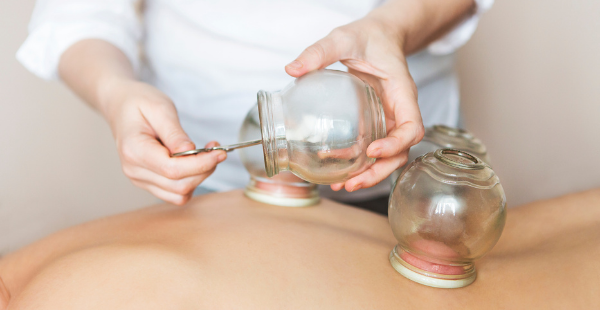You likely have seen the circular marks on the body. And you have likely heard of cupping as an inexpensive, effective, and low risk way to alleviate musculoskeletal pain, but what is cupping, and what does it do for the body?
Cupping has been used for thousands of years to treat musculoskeletal pain and various other conditions such as respiratory conditions, skin issues, and help with overall stress management.
In the various forms of cupping, a small round cup is applied to the skin to create suction over an achy and tight area of the body. In fire cupping, a flame is held into the cup prior to being positioned on the skin to create an airtight suctioning effect. And yes a licensed acupuncturist is trained thousands of hours on how to use proper technique that makes this a safe and effective therapy.

Scientific research is diving into the physiological and therapeutic effects of Cupping.
The Benefits of Cupping
- Cupping increases circulation to the localized muscles. (4)
- Cupping enables adhesions and toxins held deep in the muscle layers to rise to the surface, releasing stagnation in the body and promoting healthy, new blood to flow to the area. (4)
- Cupping boosts the immune system by stimulating localized inflammation which subsequently activates a healthy immune response, increasing the level of the tumor necrotizing factor (TNF) & interferon and promoting lymph flow throughout the body. (1)
Cupping for Treating Pain
-
One study examined chronic neck pain and how a series of five cupping treatments over two weeks influenced pain scales. Fifty patients were randomly placed into two groups: one group getting cupping treatments and the other group as a control group. After two weeks of receiving five treatments, patients in the treatment group had significantly less pain levels when measured by the Short Form Health Survey (SF-36) subscales that help objectively measure bodily pain. (3)
-
Another study looked at moderate to severe neck pain in 40 participants with them being divided into two groups: one receiving six sessions of cupping and the other group receiving a heat pad application to the local area. Both groups received treatments three times a week in a two week time period. They were later evaluated on objective pain level scores at different times over a 7 week period through the numeric pain rating scaleNPRS, the measure yourself medical outcome profile 2-MYMOP score, and the EuroQoL health index (EQ-5D). In the study, Cupping was found more effective than a heating pad in improving pain and discomfort at both the 3 and 7 week mark with the conclusion of the study being that cupping and regular exercise may be effective at reducing pain and improving neck function. (2)
“THE STUDY CONCLUDED THAT CUPPING AND REGULAR EXERCISE MAY BE EFFECTIVE AT REDUCING PAIN AND IMPROVING NECK FUNCTION.”
Interested in seeing some relief from that tension you hold in your neck and/or simply needing some time to unwind? Join us at Turning Pointe Acupuncture + Wellness where we love to incorporate cupping therapy with our acupuncture sessions!
REFERENCES
-
Ahmadi, Schwebel, and Rezaei, 2008. The efficacy of wet cupping in the treatment of tension and migraine headache. American Journal of Chinese Medicine. 37-44
-
Kim et al, 2012. Cupping for treating neck pain in video display terminal (VDT) users: a randomized controlled pilot trial. Journal of Occupational Health. 416-426.
-
Lauche et al, 2011. The effect of traditional cupping on pain and mechanical thresholds in patients with chronic non-specific neck pain: a randomized control pilot study.
-
Rozenfeld and Kalichman, 2015. New is the well-forgotten old: The use of dry cupping in musculoskeletal medicine. Journal of Bodywork and Movement Therapies. 1-6.
















